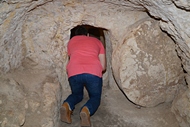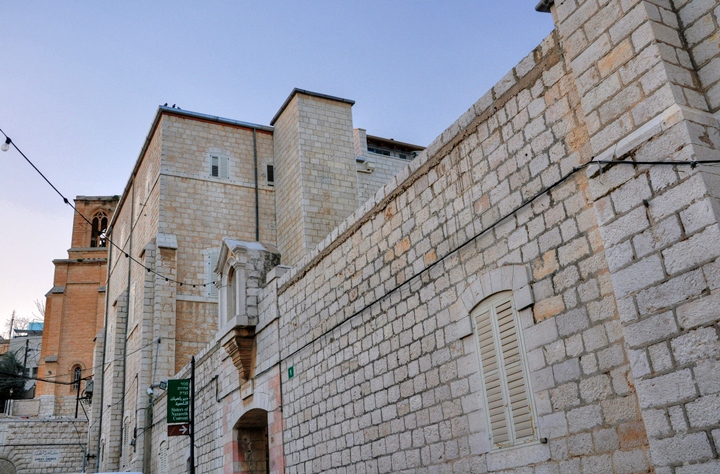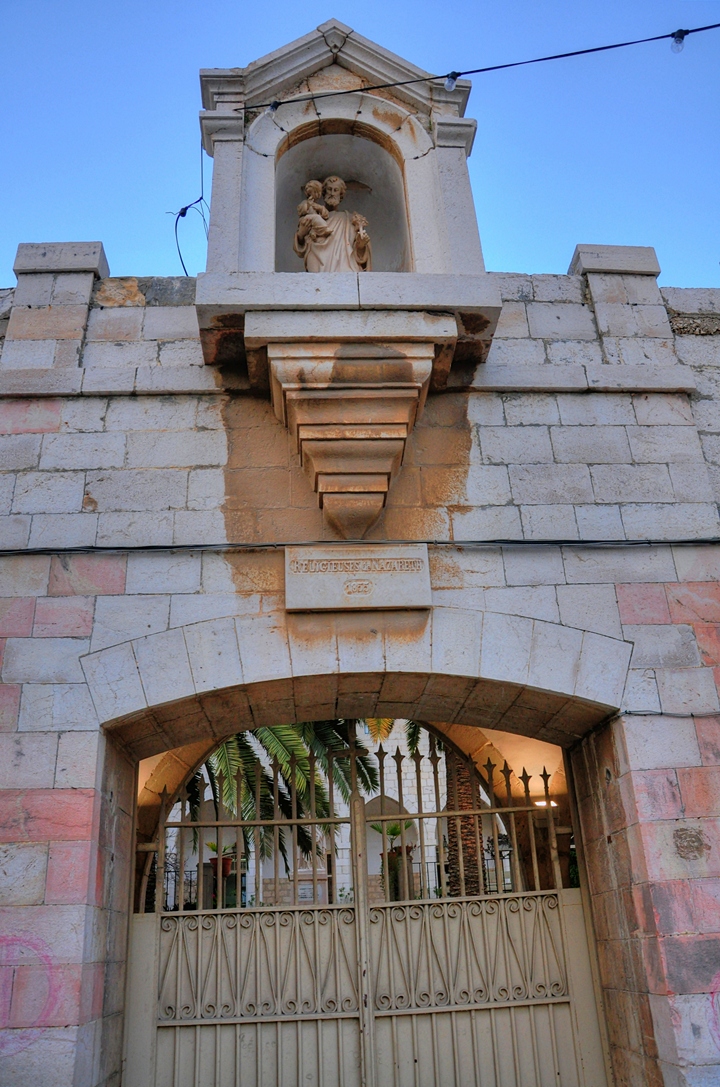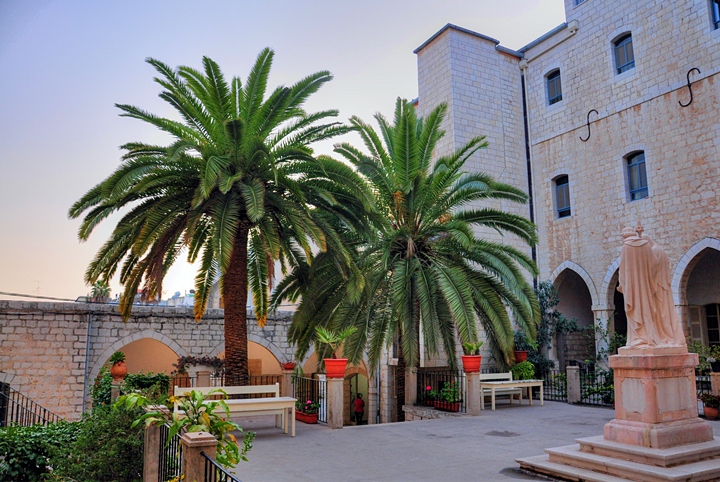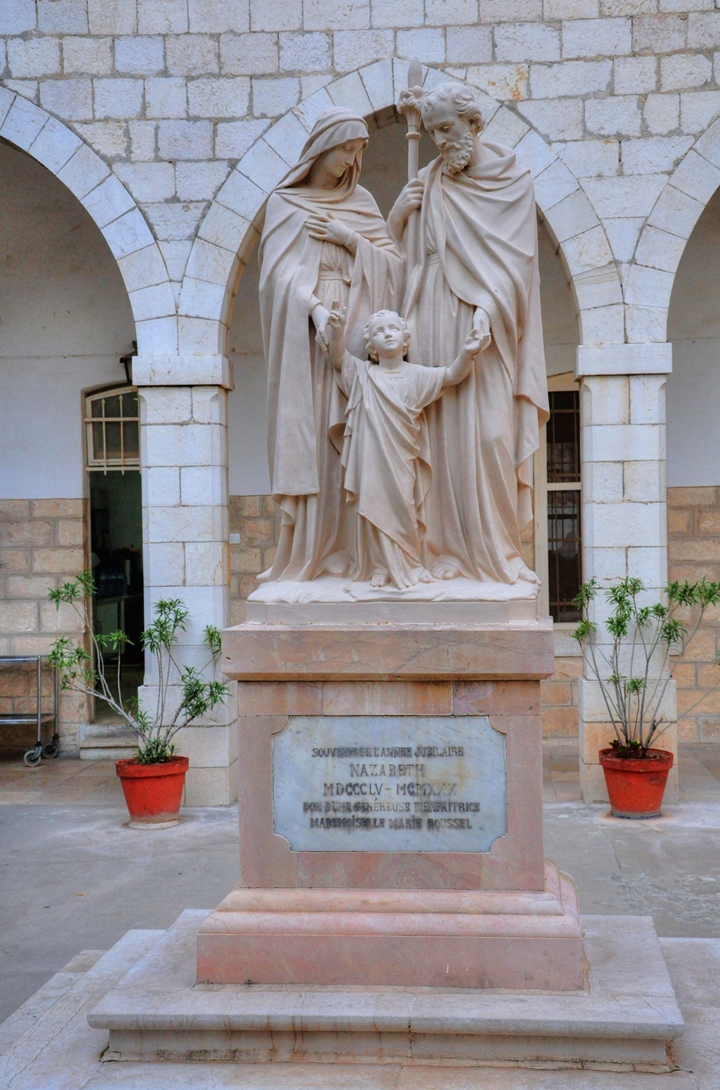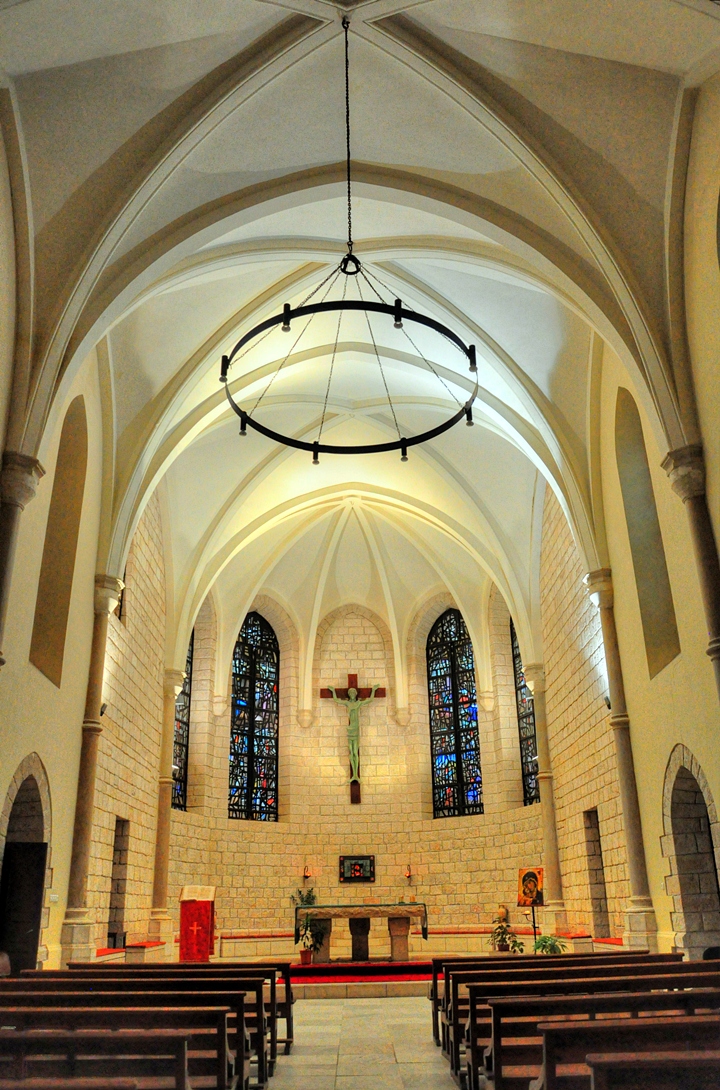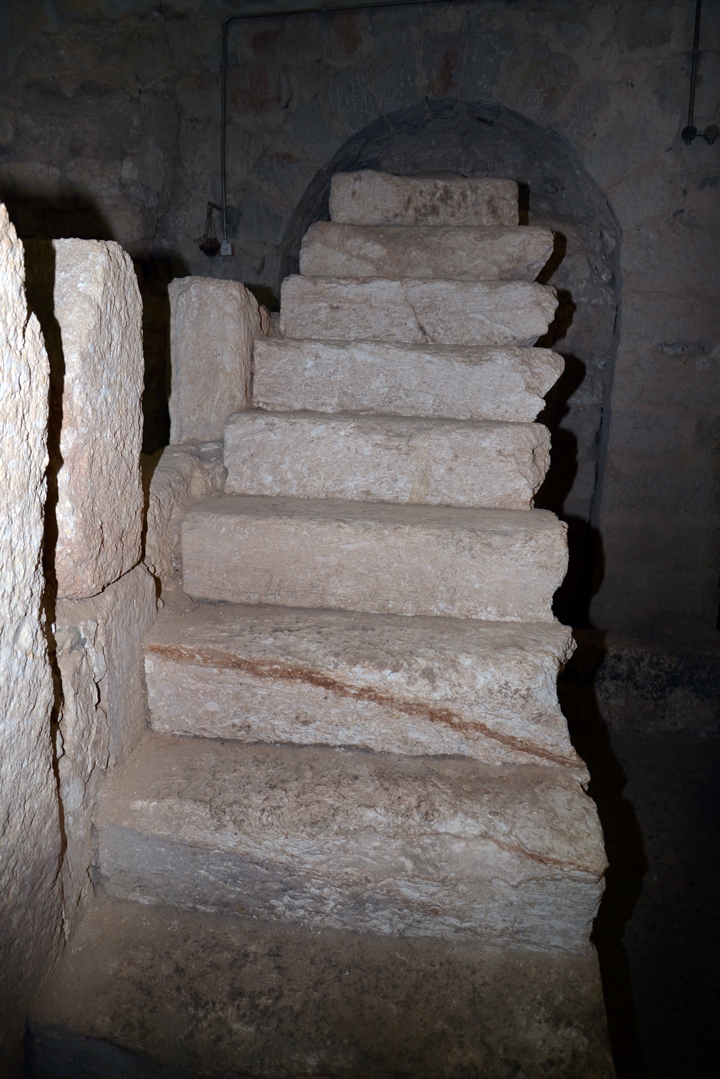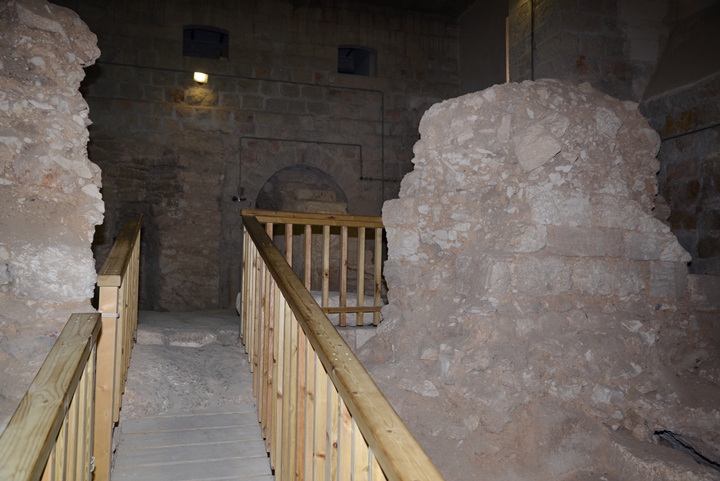The convent is located near the Basilica of Annunciation in Nazareth. Under the courtyard are archaeological findings dated to the 1st Century.
* Site of the Month July 2015 *
Home > Sites > Nazareth > Sisters of Nazareth Convent
Contents:
Background
Location
History
Photos
* Exterior
* Courtyard
* Church
* Subterranean
References
Background:
The Convent of the Sisters of Nazareth is adjacent to the Basilica of Annunciation. It operates a school, a hostel and a church. Under its courtyard are ancient remains dated to the Early Roman period.
Location:
The place of the convent is located adjacent and south to the Basilica of Annunciation in Nazareth.
History of the place:
- Ottoman period
In 1881 a group of French nuns arrived in Nazareth and purchased stores and land. They then constructed a convent in adjacent to the Church of Annunciation .
Archaeological evidence was discovered in 1884 at the site on which they were constructing their convent. This included underground rooms, built walls and tombs, some of which date to the 1st Century AD. The area of the excavations had been a Jewish burial site in the Roman period, but it also contained a dwelling in use prior to the construction of at least one of the tombs, itself dated to the 1st century. The archaeological evidence at the convent remained almost entirely unpublished, and almost unknown to archaeologists, until 2006 when it was the subject of a 5-year study by the Nazareth Archaeological Project, directed by Ken Dark from the University of Reading in England. Although no new excavation was conducted, modern archaeological recording of the existing remains and objects found, and re-analysis of the records made during nineteenth- and twentieth- century excavations, make it possible to date what was found at the convent much more accurately, and to interpret it in the light of what is known from other Roman and Byzantine sites.
- Modern times
Today the convent operates a school for deaf and blind children, a hostel for pilgrims, and a church. The church and the subterranean remains can be visited, but require an appointment.
Photos:
(a) The exterior:
The photo shows the east side of the monastery, on 6167 street of the Latin quarter of Nazareth.
Click on the photos to view in higher resolution…
The entrance to the convent is through a beautiful gate, as seen in the photo below.
On top of the gate is a small statue of Saint Joseph holding infant Jesus.
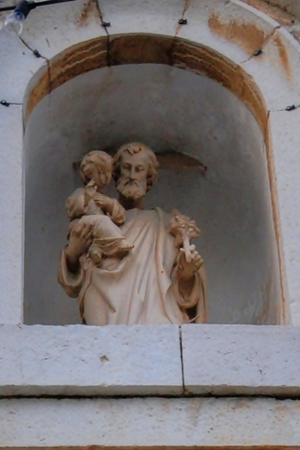
Detail of the entrance gate
(b) Courtyard:
After entering to the convent, an open courtyard separates the residential buildings (on the right) to the church (behind).
The base of the statue of the Holy Family, located in the center of the courtyard, bears the date of 1855 (MDCCCLV) when the construction was started.
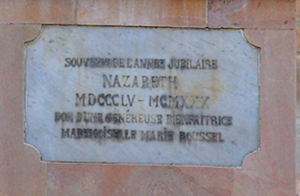
Inscription on the base of the statue
Under the courtyard of the convent is a first-century tomb, once sealed by a rolling stone, and an earlier house dating from the same century.
(c) Church:
The Church is located on the north side of the courtyard. The main altar faces east.
A closer view of the altar:
A vitrage – stained glass – is typical of European Churches interiors. Here it is embedded in the four panels of the eastern wall around the altar. This art form reach its height in European Churches during the Middle ages, as it was used to enter colored light while illustrating Biblical scenes.
On the side of the altar is a Bible, opened on Gospel of Luke Chapter 24 (Latin: Evanglium Secundum Lucam).
-
Art in the Church
On the wall is a picture on canvas illustrating Mary and infant Jesus. Greek initials appear on the top left and right side: MP ΘΥ – Greek initials meaning: Mary Mother of God.
Another painting of Joseph is in the next photo. Greek letters of Joseph’s name is on the right (ΙΩΣΗΦ – Yosef), while on the left (ΟΑΓΙΟΣ) stands for Saint .
Joseph holds a pair of pigeons, which were offered according to Jewish law to the temple in Jerusalem after the child’s birth. (Luke 2: 22-24):
“And when the days of her purification according to the law of Moses were accomplished, they brought him to Jerusalem, to present him to the Lord; (As it is written in the law of the LORD, Every male that openeth the womb shall be called holy to the Lord;) And to offer a sacrifice according to that which is said in the law of the Lord, A pair of turtledoves, or two young pigeons”.
Another picture originated from Greece, depicting Mary and infant Jesus. It is known as the Theotokos (“God bearer”) of Vladimir, a fine medieval Byzantine icon of the Virgin and Child originating from the 12th Century Russia. The painting is also on display in the form of a mosaic picture in the courtyard of the Basilica of Annunciation.
(d) Subterranean ruins:
Archaeological evidence was discovered under the convent, including a dwelling house, tombs, water cisterns and a church. These date from the 1st century AD and the Byzantine, Crusader and Ottoman periods.
Guided tours are limited and must be requested in advance. Our private tour was graciously guided by an Italian nun, Sister Stefania, and we thank her for her assistance.
Thanks also to Ken Dark for his inputs and corrections.
A freehand sketch of the underground complex is illustrated here, indicating the points of interest which are detailed in the remainder of this page.
The complex consists of a number of rock hewn cavities, cut for various functions over a period of 2,000 years, and built walls of various dates. The area is oriented south-north, where the north side against the hillside.
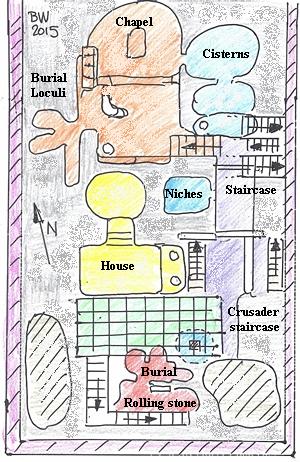
-
Topography
Ken Dark has drawn attention to Roberts illustration of Nazareth in 1839, which was painted before the construction of the convent.
The location of the site, as indicated on the illustration, is on the slopes of the Nazareth hills. The modern Casa-Nova street follows the path of the wadi, passing on the west and north sides of the Annunciation Church.
The structures found under the convent were cut into the hillside, on the southern end of the limestone ridge, parallel and above the wadi. This dictated the plan of the Roman period house, the tombs and cisterns, and the constructions of the post-Roman period structures, and it also meant that the rock-cut walls survived better than the usual stone-built walls.
Part of David Roberts illustration, 1839 ; Library of Congress collection
-
Descent to the underground complex
A modern staircase leads down from the monastery to the underground complex.
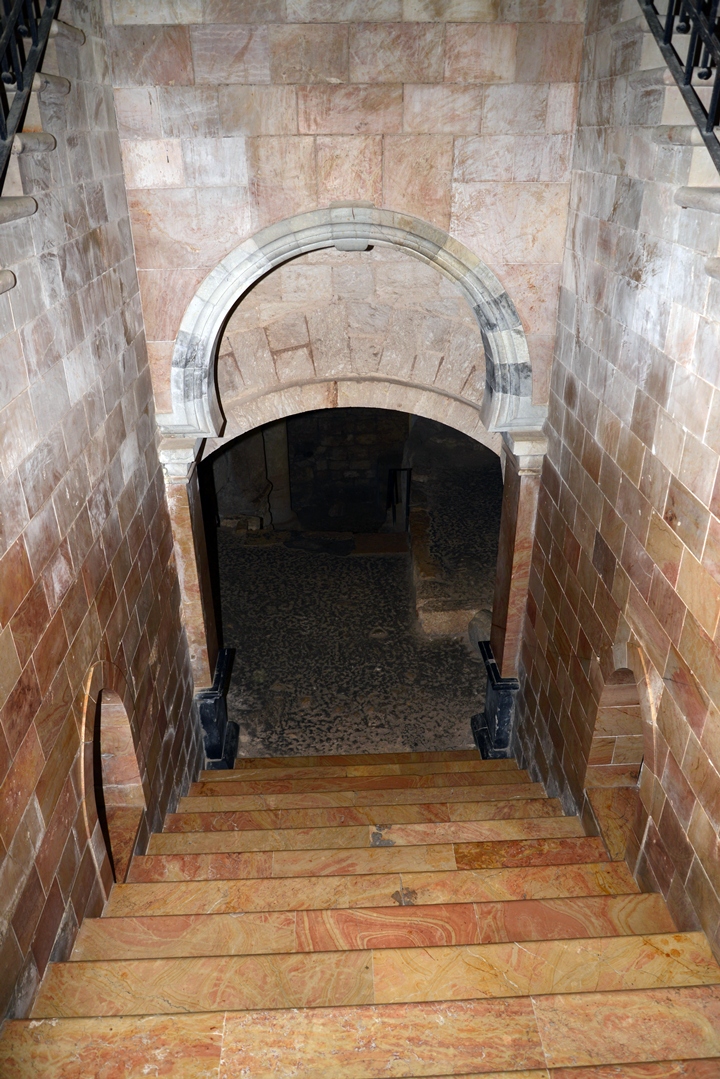
The staircase leads right to an underground rock hewn chapel, or cave-church. A pair of steps lead up to the cave, where an altar is located.
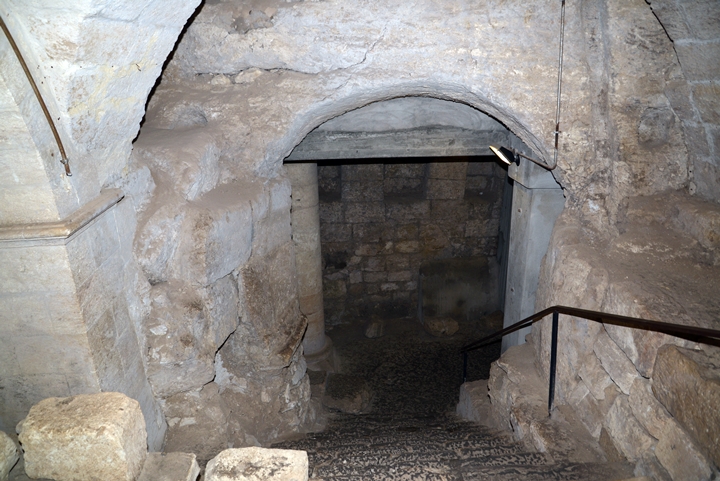
-
Chapel and cisterns
The staircase leads right to an underground rock hewn chapel. A pair of steps lead up to the cave, where an altar is located.
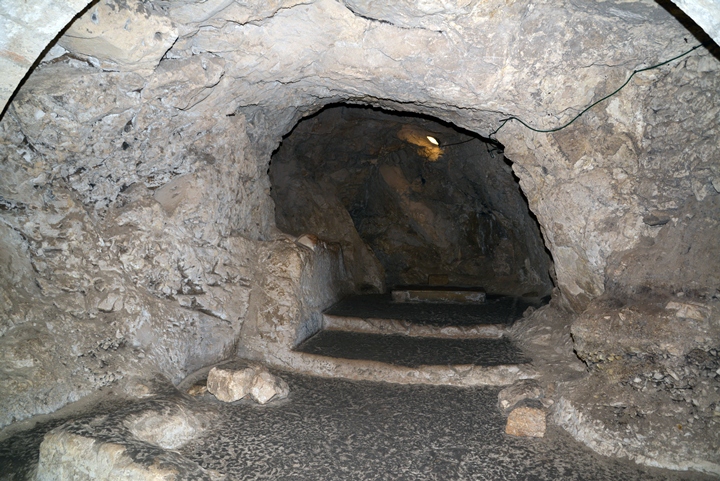
The cave-church is located under an opening, seen in the photo below. This opening is a light-well, a feature found in other Byzantine churches and designed to let natural light onto the altar, which presumably stood below it. Today the base of a modern altar stands in approximately the same position.
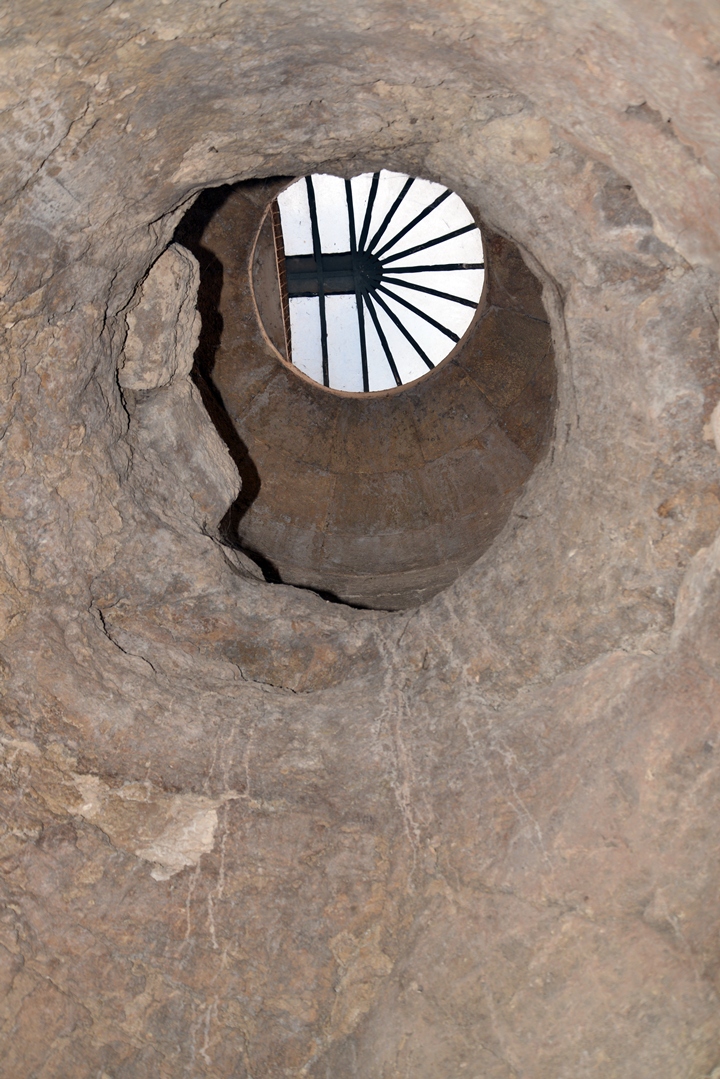
The cave-church was made in the Late Roman or Byzantine period by cutting back into the rock from one side of a Roman-period tomb, remains of which can be seen in the cave-church.
The location of the chapel is indicated on the map with a red square.
The following photo is a closer view of the cave-church. When the cave was excavated in the nineteenth century, the nuns found a skeleton of a man in a crouched position to the left of the L-shaped stone on the bottom left side. This burial was probably part of the tomb preceding the cave-church, but carefully preserved inside it when the cave was cut into the rock.
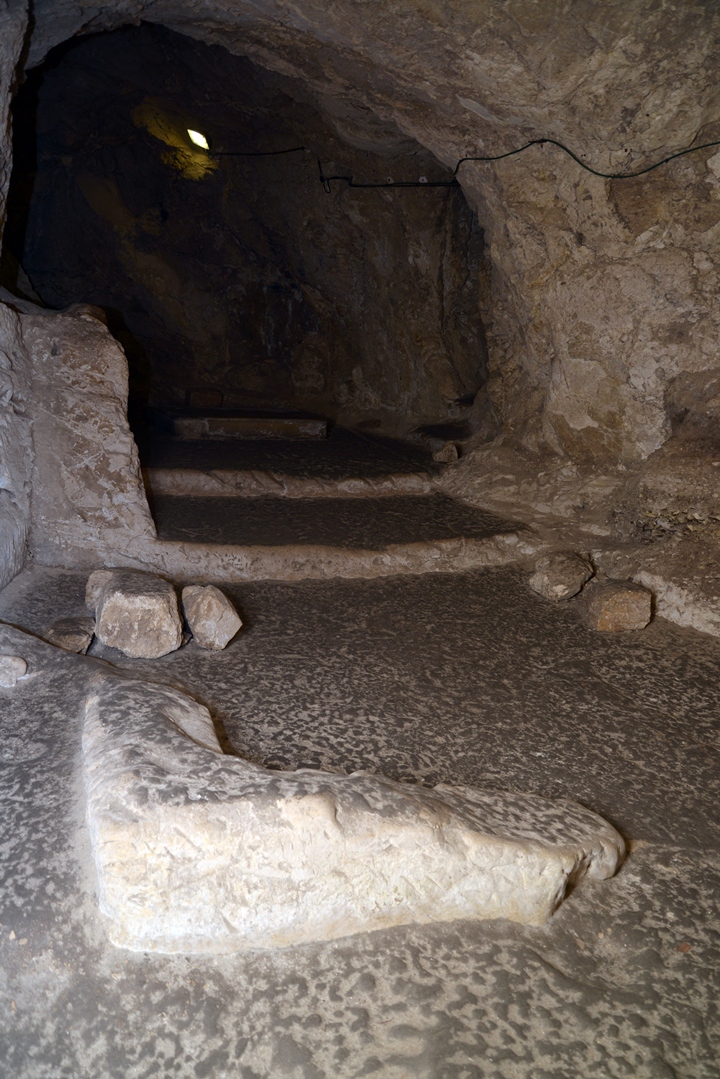
On the western wall of the chapel is a number of small basins, all connected to each other by a small hole.
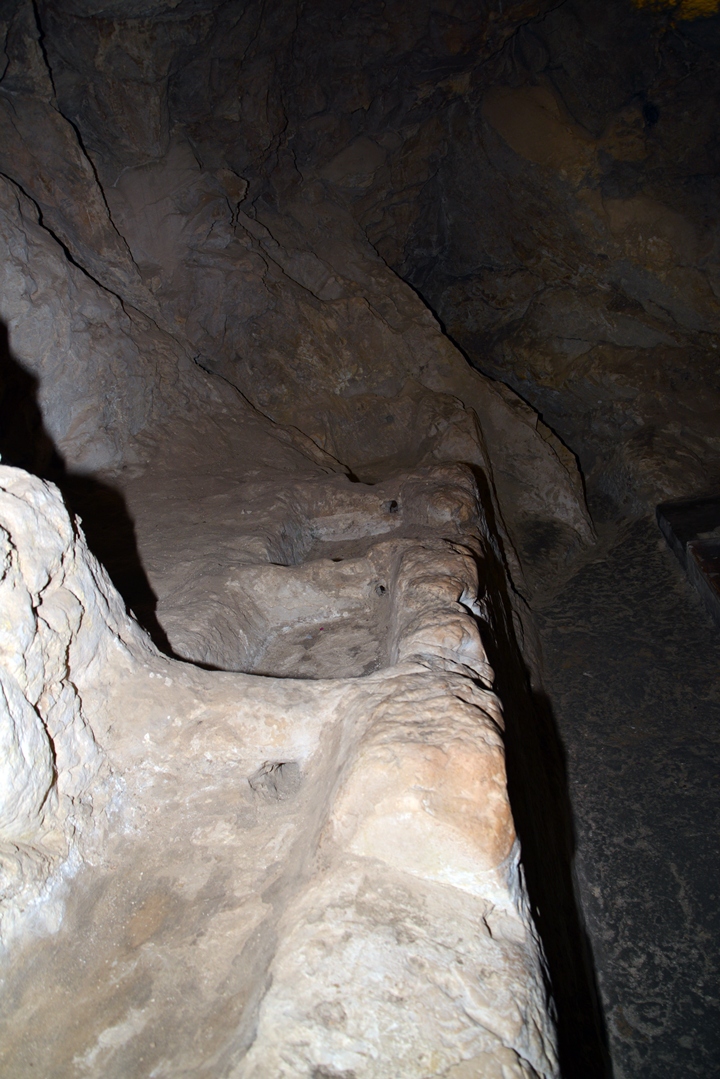
This might have been an agriculture installation, used by the monastery to produce wine. Guessing from the type of installation, it may be dated to the Byzantine period.
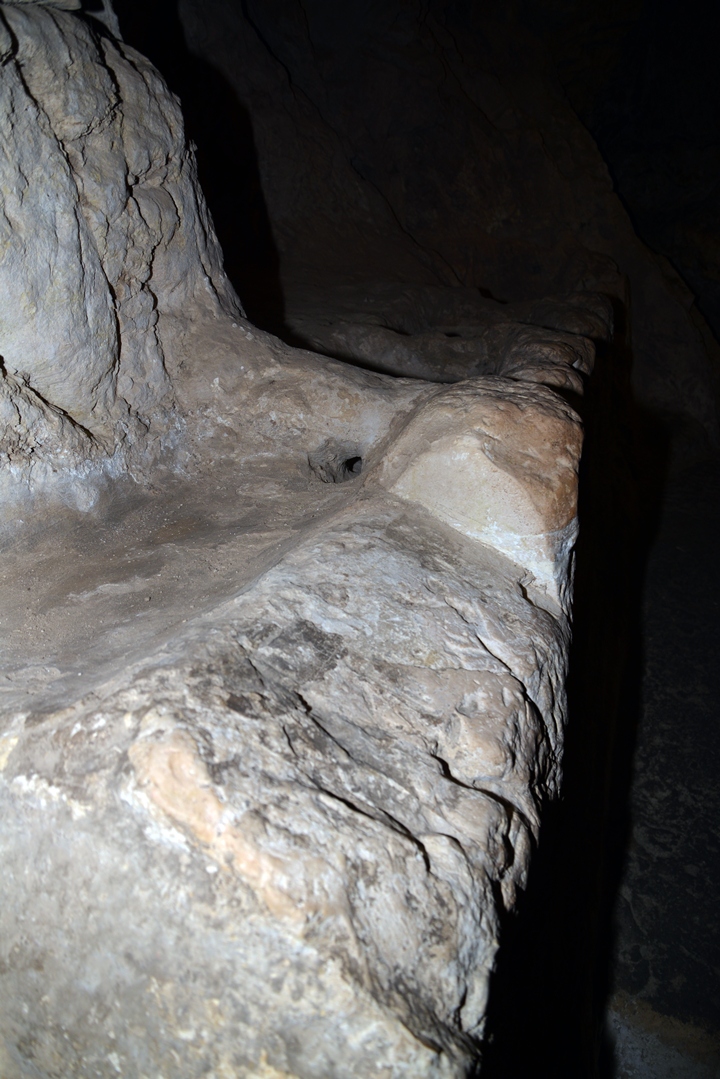
-
Burial Loculi (North)
Another trace of the earlier, Roman-period, tomb can be seen at the south end of the cave, where a pair of burial cavities (loculi) are hewn at the edge of a narrow passage on the south west side of the cave-church. One of these had a complete skeleton at the time of discovery. These were again carefully preserved when the cave-church was constructed, showing the respect its builders had for the earlier burials.
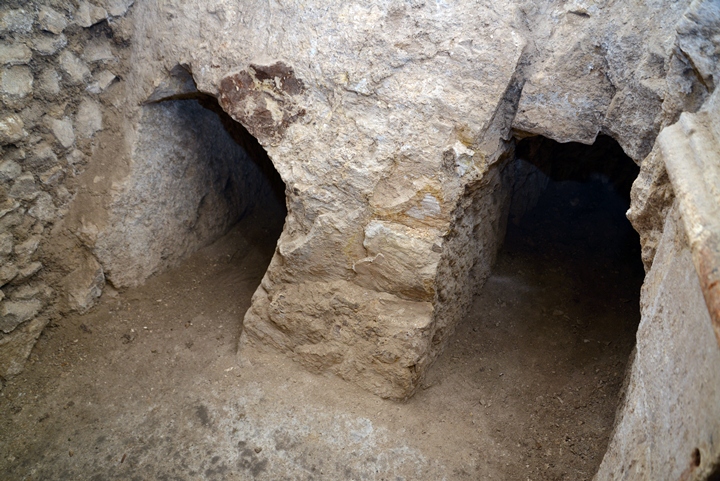
Another cavity is adjacent to these loculi. It opens to a passage to the western wall, where according to nineteenth-century reports there were additional rock hewn loculi.
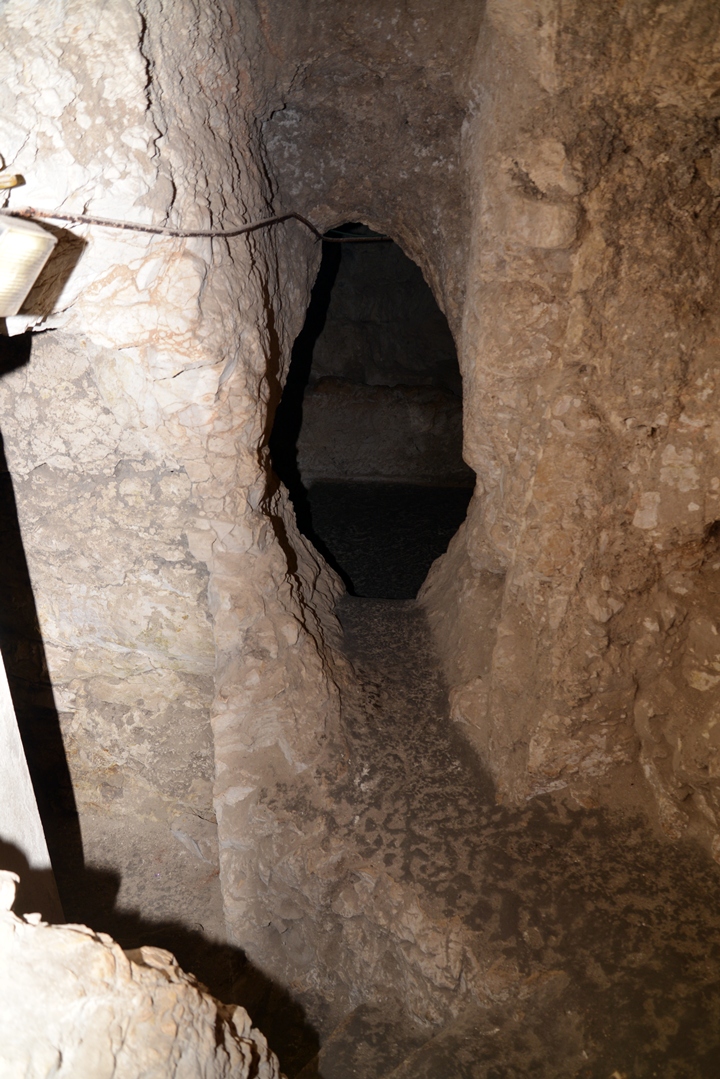
-
Corridor
Turning left from the modern staircase, a corridor between the south and north sections passes along another set of niches in the wall, although these are of much later date, and then opens into a number of chambers.
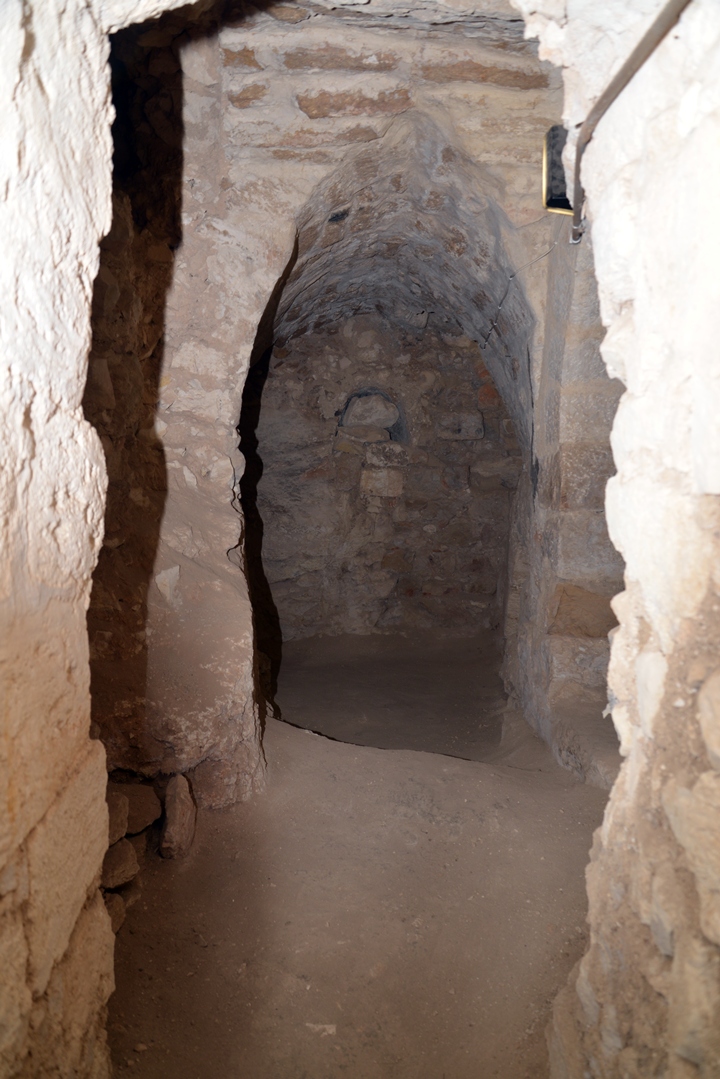
-
Crusaders period staircase
On the south side of the complex, adjacent to the dwelling house, is a pair of staircases. They are dated to the Crusader period. The location of the two staircases is indicated on the map with a red square.
The photo below shows eastern staircase, located behind an arch.
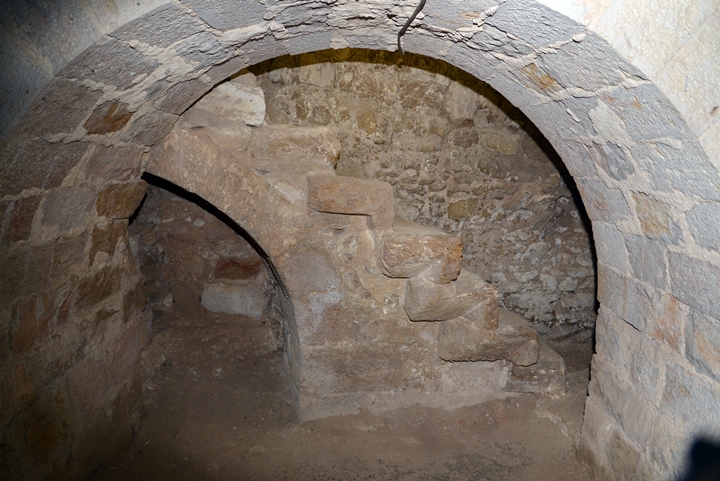
The other staircase is seen here:
Another view of the western staircase is seen here. The wall and the staircase are from the Crusader-period. It is possible that, although certainly rebuilt in the Crusader period, this wall may have been based on an Early Roman period wall, belonging to the house on the west side.
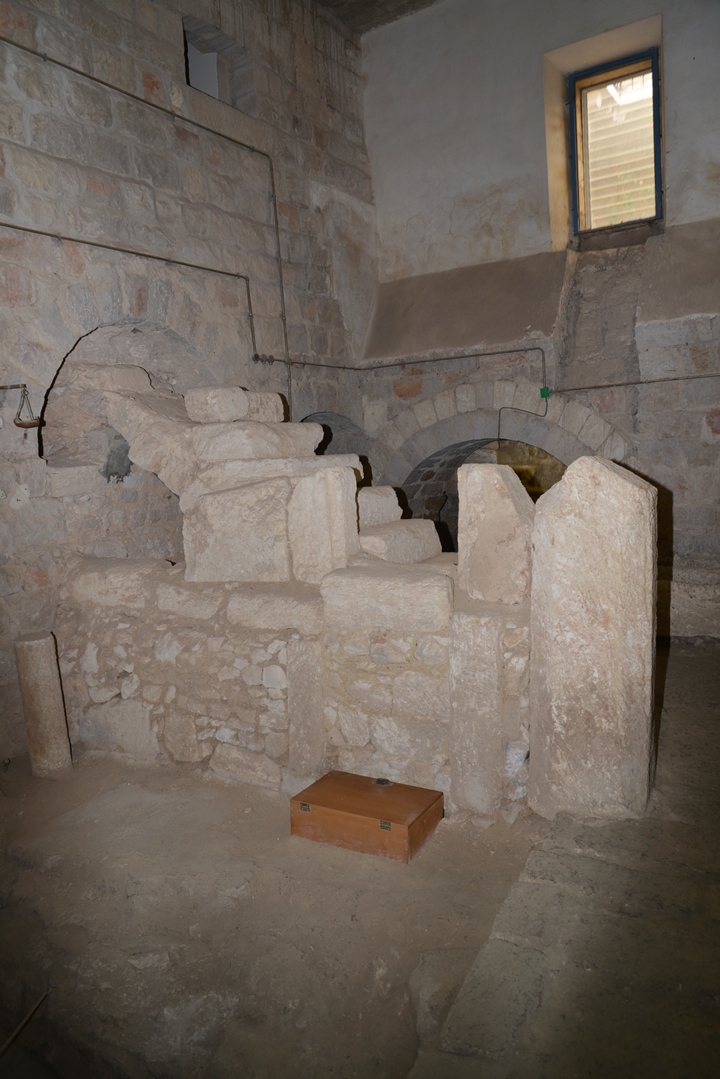
Another set of steps is located on the western side of the cellar.
-
Early Roman House
Ruins of a dwelling are located on the south side of the complex, partially cut into the hillside rock.
The location of the house is indicated on the map with a red square.
The photo below shows its entrance and the wall on the left side.
Part of the original floor of the house can be seen just inside the doorway. Professor Ken Dark interpreted this structure as an Early Roman period house, perhaps the type of “courtyard house found at other sites. It can be dated to the 1st Century AD. The large area in front of the opening was the largest room, while the small opening was an entrance to the northern smaller room.
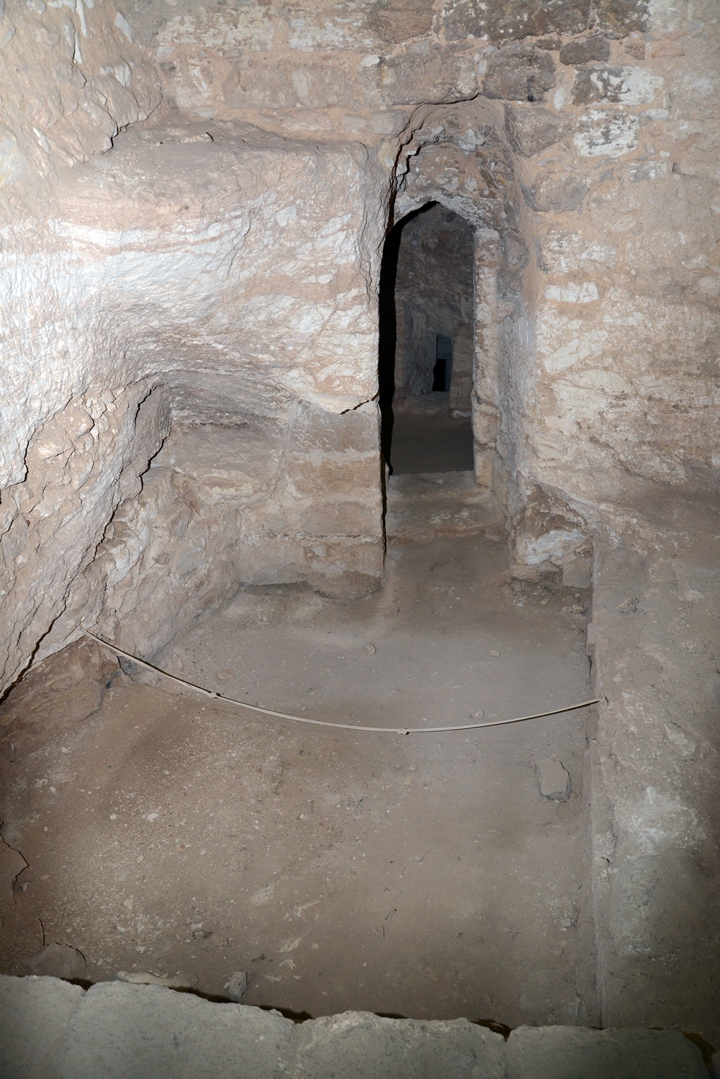
Professor Ken Dark was able to show that after the house was disused small-scale quarrying cut away part of its southern side. This quarrying was, in turn, cut into by the deep forecourt of another tomb, of a type dateable to the first century AD. So a sequence of house, then quarrying, then tomb could be seen, probably all before the end of the first century.
Records made when the present convent was built show that a large Byzantine church, decorated with floor- and wall-mosaics, once stood above the visible remains. Ken Dark has argued that this surface-level church was the Byzantine Church of the Nutrition, described in the seventh-century pilgrim account De Locis Sanctis. The Byzantine Church of the Nutrition was said to have had preserved in its crypt (cellar) the house where Jesus was brought up. Ken Dark has suggested that the 1st-century dwelling house visible today was the house that the Byzantines believed was the house where Jesus was brought up, but says that it is impossible to know today whether the Byzantines were correct in believing that. The location of the house, only 100m from the Annunciation Church, combined with its Second Temple period date, makes this a serious possibility, but, as he says, it is impossible for archaeology to prove.
On both sides of the house are sections of Crusader -period wall. There is also a small section of the western wall of the Early Roman period house, seen here on the bottom left side.
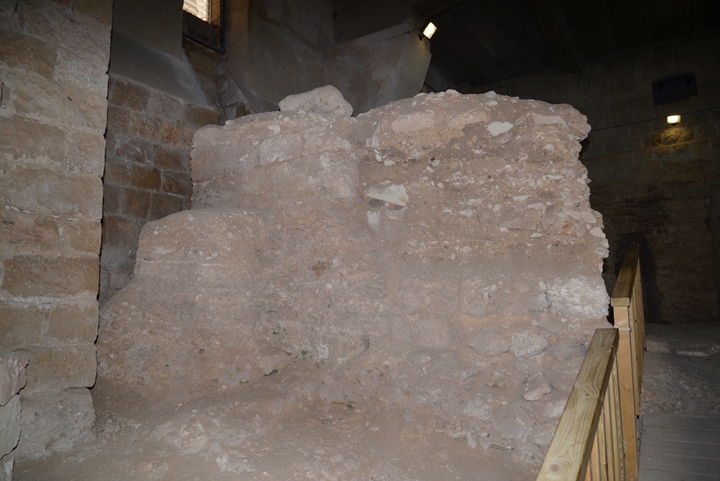
Surviving fragments of rock-cut wall show that the house originally extended to the west, east and south, but it is impossible at this time to determine its exact dimensions and total plan as only part of it is within the present cellar. The surviving part of the larger room was rectilinear about 10m long by 4-5m wide, with the smaller concealed room 2m long by 4-5m, built against the slope of the hill which rises to the north. According to the “Courtyard” house model, the main family room would have been beyond the western wall, while a courtyard with a cistern would have been located to the south.
Further excavations at the site are unlikely to take place, but even on the basis of what is already known this may well be one of the most important archaeological sites in Nazareth.
On the rock to the side of the house is a small engraving. It is not clear what this means, nor what date it is.
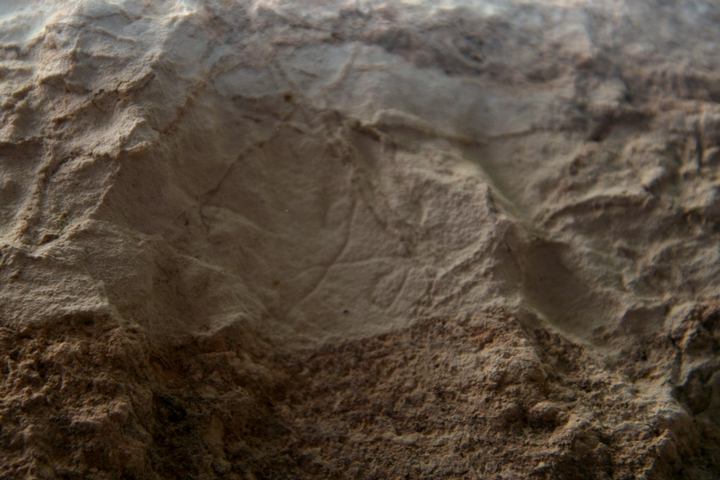
Sister Stefania also pointed out another engraved sign on the rock, which looks like a fish.
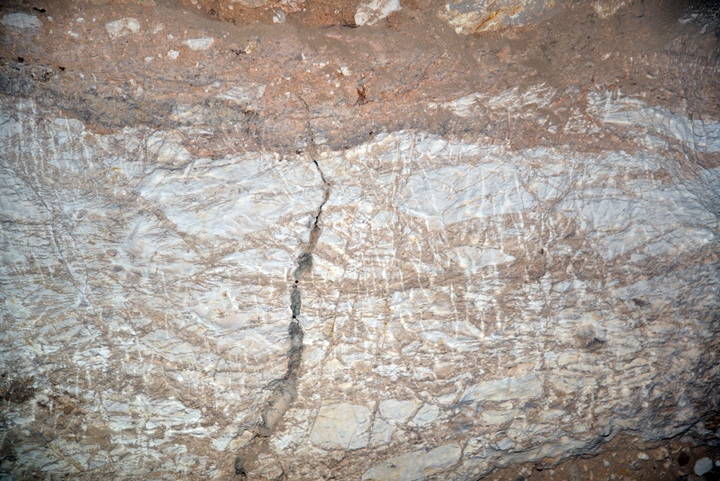
-
Crusaders platform
A rectilinear paved platform is located in the front of the house, dated to the Crusaders period. An east-west wall, seen on the left side, is also dated to the Crusader period.
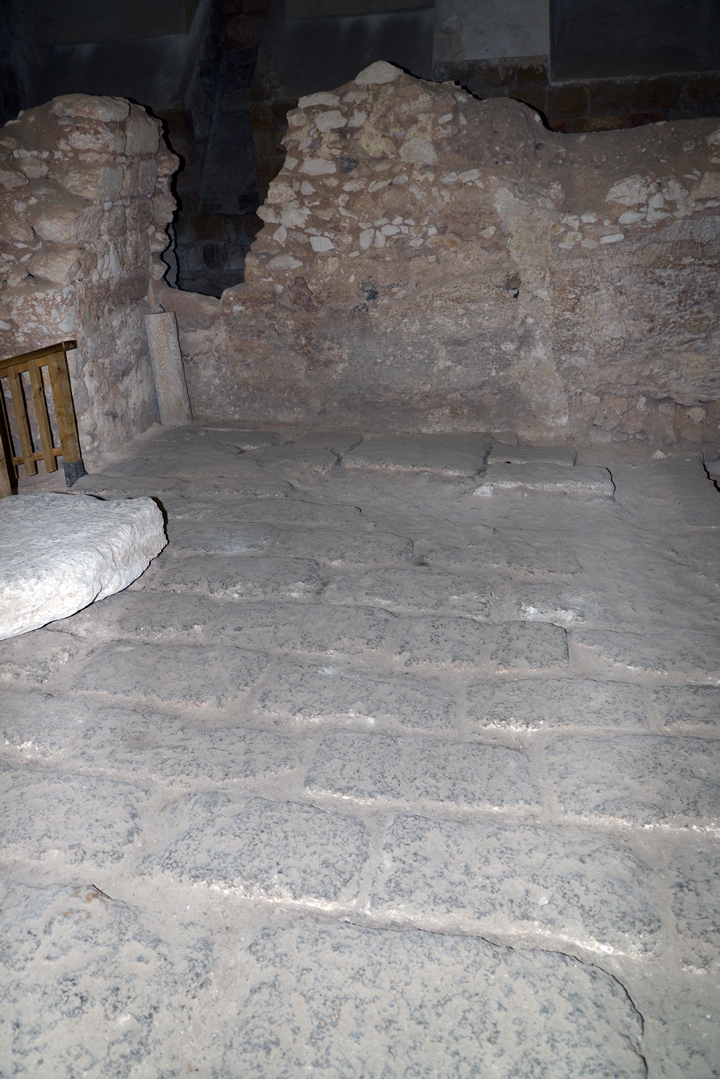
On the corner of the paved platform is a covered opening to a vertical shaft. Ken Dark suggests that this is a Crusader-period squint, a feature found in medieval Western European churches, placed to allow medieval pilgrims to view the altar beneath, inside a small chapel located on the side of the tomb below.
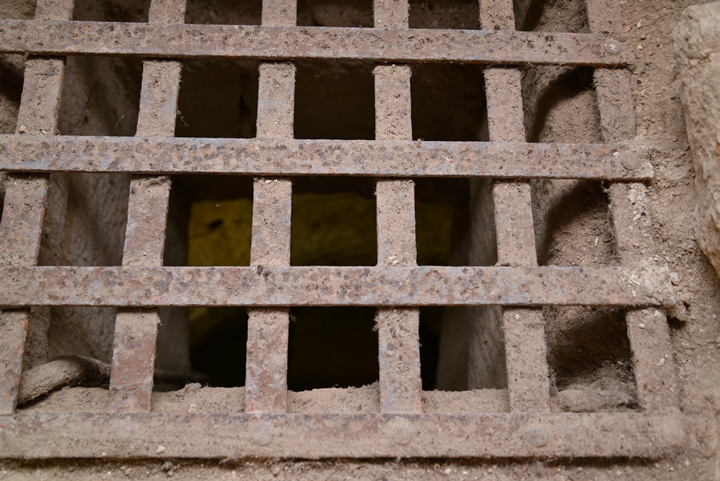
-
Burial Loculi (South)
An Early Roman-period tomb (mentioned above) is cut into the rock-face immediately south of the house. This is well-preserved and again contains loculi (burial cavities).
The location of the tombs are indicated on the map with a red square.
A modern wooden bridge leads down to the level of the tombs.
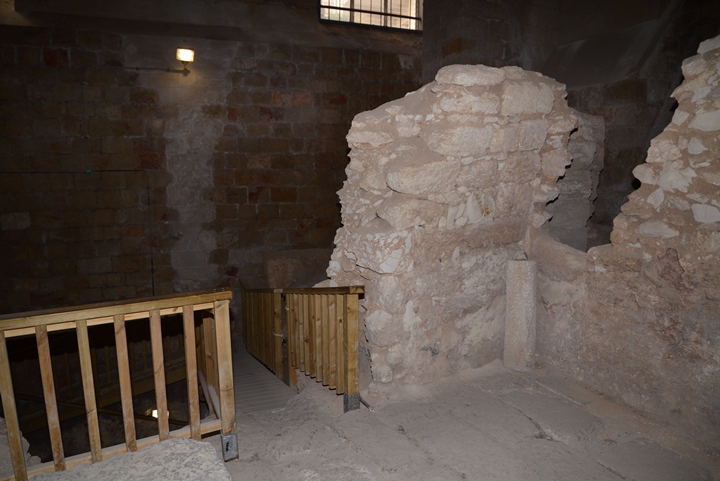
A reverse view from the bridge towards the platform level of the house is seen in the following photo:
On the level under the residential house is an opening to a family burial cave. A rolling stone seals the entrance.
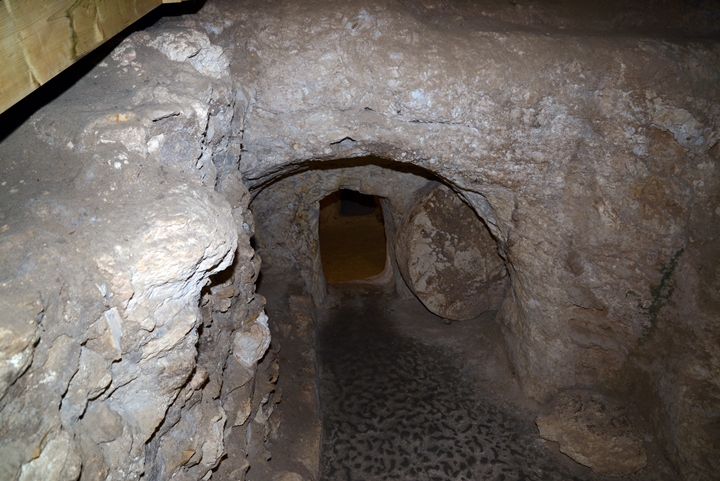
The deep courtyard in front of the entrance to this tomb is that which cut through the earlier house. On one side it is possible to see the rolling stone that once sealed the entrance to the tomb itself.
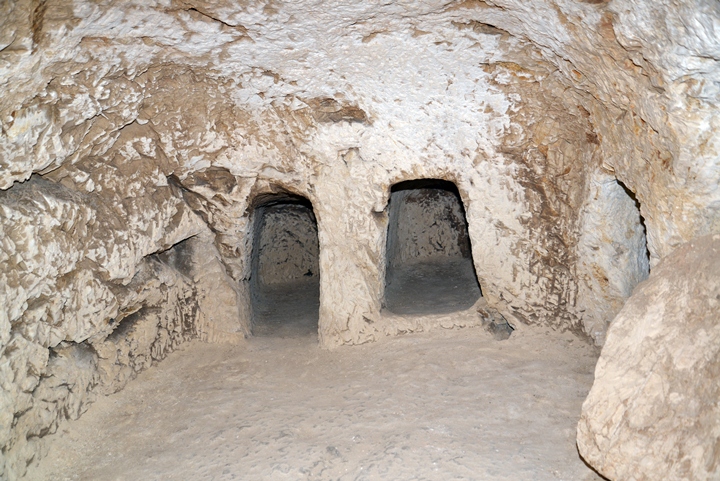
A number of burial cavities are cut inside the tomb. This burial type was a Jewish tradition during the Roman and Byzantine period, and thousands of rock hewn burial loculi exist in the Holy Land. This practice is based on the sacred Jewish religious duty of proper burial, as attested in numerous cases in Scripture.
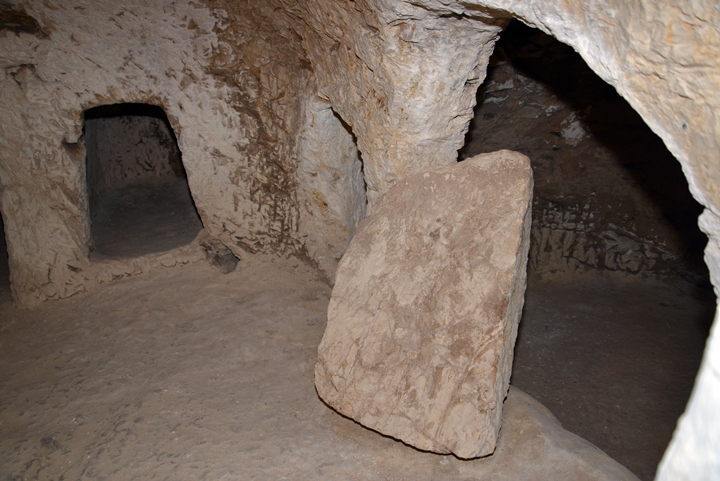
Note that it is unusual to find tombs near a residential house, as cemeteries were always located outside of the Jewish residential areas. However, in this case the tomb cuts through quarrying, which cut through the disused house. So the house was out of use before the tomb was constructed.
-
Rolling stone
A rolling stone (Hebrew: Golel) is located at the entrance to the tomb. It is 33 cm thick and 109 cm in diameter, and slides in a rock cut groove. This heavy stone was used to seal the entrance after the burial of a family member, in order to stop animals and grave-robbers entering, and also to prevent the “impurity” (Tum’ah) escaping.
The use of rolling stones started in the Second Temple period, and then became very common throughout the Roman and Byzantine periods, but the design of these tombs changed in that time. For example, tombs dated to the first Century AD, as at the Sisters of Nazareth, have larger rolling stones than those dated later.
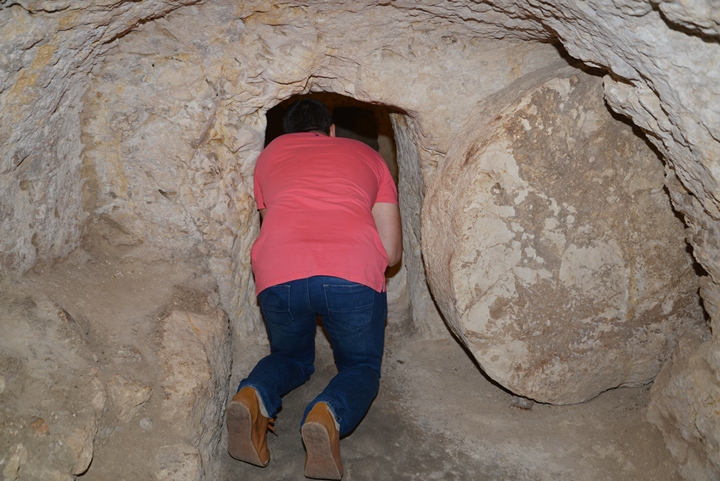
During the first temple period, tombs were sealed with square blocks. The use of rolling stones started in the second temple period, and then became very common throughout the Roman and Byzantine periods.
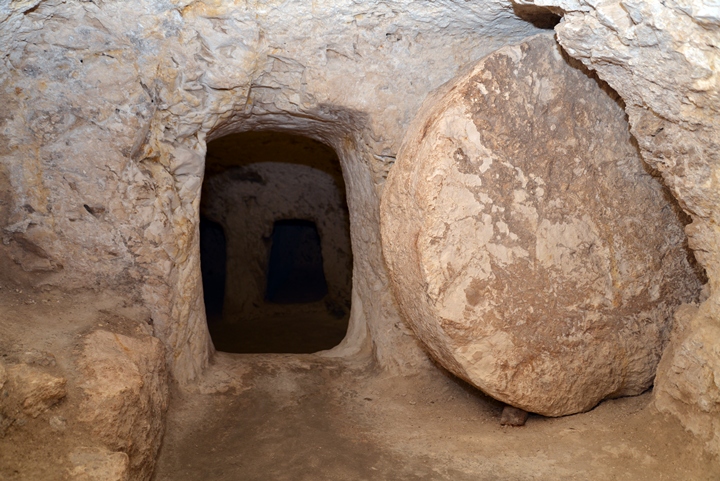
This fact was used by critiques of the earlier dating time of the tomb, as they claimed that rolling stones were used only during the middle of the 1st Century AD, suggesting that the tombs are dated later than 100 AD. Future excavations could shed more light on the dating issue.
References and Links:
- Phone for booking a visit: +972-4-6554304. Donations appreciated.
- Hostel information on Tripadvisor
- Jewish burial traditions and the Resurrection of Jesus – Dr. Craig Evans [pdf; 13 pages]
- Could this be the home of Jesus?
- Jesus Childhood home (Youtube)
- Early Roman-Period Nazareth and the sisters of Nazareth convent – Dark K. (2012, 31 pages pdf)
* Internal:
BibleWalks.com – virtual visit to the place of Holy Nazareth
Jesus Table <<<—previous Nazareth site —<<<All Sites>>>
This page was last updated on July 9, 2015 (Corrections to the texts)
Sponsored links:
